- There are no more items in your cart
- Shipping Calculated at checkout
- Sub-Total (inc. VAT) £0.00
Need Help?
Marine Topcoats
Marine topcoats are vital for safeguarding boats and vessels against the demanding conditions of marine environments. Designed for durability and protection, these specialist coatings shield against saltwater, UV exposure, and mechanical wear, ensuring a resilient finish that prolongs the lifespan of boats and marine structures. Available in various finishes and colours, boat paints provide both functional protection and a polished appearance, catering to a wide range of applications from commercial ships to recreational boats. For tailored advice on product selection, contact the technical support team at Rawlins Paints. Click for more info.
Subcategories
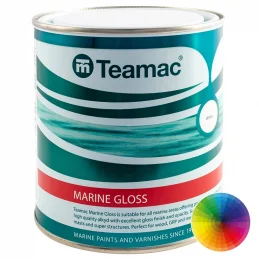
Teamac Marine Gloss
2,600+ Colours. High-quality marine gloss paint designed for a durable finish on marine structures. For general marine areas, including bridge fonts, deck work, masts, and superstructures. High weather resistance.Buy A Paint Colour Sample
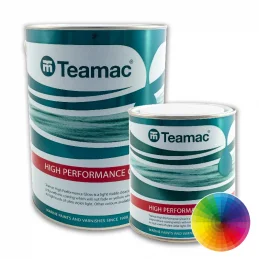
Teamac High Performance Polyurethane Topcoat
2,400+ Gloss Colours. Two-pack aliphatic polyurethane coating designed for marine applications. For GRP, wood, ferro concrete, and suitably primed metals; not to be used on conventional solvent-based paints. Resistant to fading or yellowing from UV exposure. Anti-fungal properties. Professional use only.Buy A Paint Colour Sample...
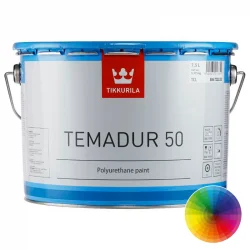
Tikkurila Temadur 50
Time-proven, easy-to-use general purpose topcoat in 4,000+ colours for constructional steelwork and machinery, with a wide range of colours to choose from.Two-component, durable and non-chalking semi-gloss polyurethane paint, hardener aliphatic isocyanate. Forms a durable, easy-to-clean and non-chalking topcoat with good gloss and colour...
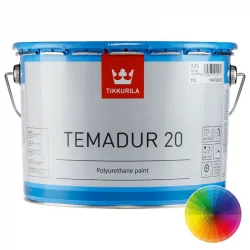
Tikkurila Temadur 20
2-pack semi-matt polyurethane paint with 3,800+ colours that can be used as a single-coat paint for steel, zinc and aluminium surfaces with its anti-corrosion pigmentation, and also used as a primer or as a semi-matt topcoat in epoxy-polyurethane systems. It is also suitable for use on uPVC.Resistance to weathering and abrasion MED...
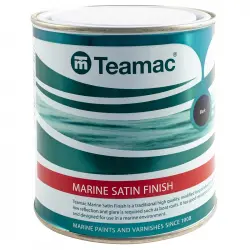
Teamac Marine Satin Finish
In black and red. High-quality marine satin finish paint for marine environments. Resistant to oil and water. For boat roofs, GRP, iron, steel, and wood. Low reflection and glare. VOC content under 500 g/l.
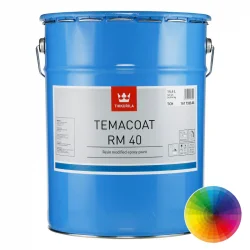
Tikkurila Temacoat RM 40
2-component, resin modified epoxy primer/topcoat with 4,000+ colours that can be used as a single-coat system.Good adhesion to steel, zinc and aluminium surfaces exposed to severe abrasion or chemical stress. Suitable for concrete surfaces and has a CE marking. Can be used on steel structures in wet environments, e.g. inside pontoons,...
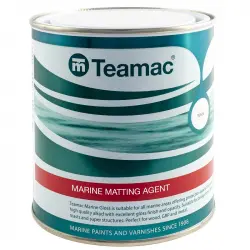
Teamac Marine Matting Agent
Marine matting agent, designed to reduce gloss levels when mixed with marine coatings. For marine surfaces, including wood and metal. Final finish depends on mixing ratio.
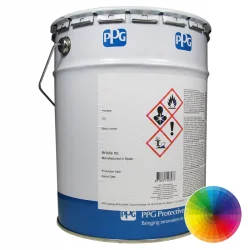
PPG Sigmarine 48
General purpose gloss paint in 2,600+ colours. Based on an alkyd-modified resin that is particularly suitable as a finish for boot-top, topside, deck and deck equipment. Quick-drying. Water and weather resistant coating. Can be applied over most intact alkyd paints.Order a Colour Sample
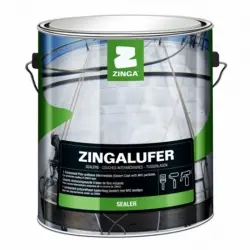
Zinga Zingalufer
Intermediate layer or topcoat for existing layers of Zinga in immersed or chemical environments, such as ship hulls and sewage works, providing a protective seal against salt and chemical exposure. Apply by brush, roller, conventional sprayers or airless spray. One pack system. Dry in as little as 4 hours (see drying times table in...
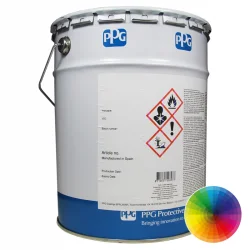
PPG Sigma Vikote 56
Modified acrylic finish coat for above-water areas, in 2,600+ gloss colours. Featuring good gloss and colour retention, resistance to water and splash of mild chemicals. This fast-drying coat can be applied at temperatures down to –10°C. Dries in as little as 30 minutes (@ 20°C). Apply by spray, brush or roller.Order a Colour...
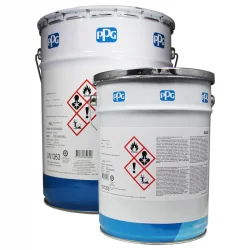
PPG PhenGuard Subsea 780
2-component, amine adduct-cured phenolic epoxy finish, used for the protection of subsea equipment. Also known as Subsea 780 and Sigmaline 780. Qualified for NORSOK M501 Rev.6 System 7C up to 150°C with 3 coating system (Phenguard 930 / 935 / Phenguard Subsea 780 system). Qualified for NORSOK M501 Rev.6 System 7C up to 180°C with 2...
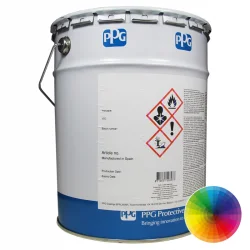
PPG SigmaDur ONE
Single-pack urethane polyester finish coat in 2,600+ colours for onboard maintenance on topsides, decks and superstructures.Quick drying. Pre-reacted binder, no free isocyanates added. Easy application with excellent flow and levelling properties. Recommended application is by brush and roller only. Good adhesion on most aged, sound...
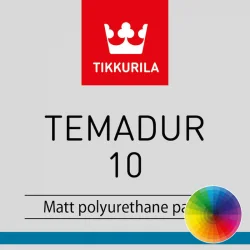
Tikkurila Temadur 10
Tikkurila Temadur 10, a two-component matt polyurethane paint containing anti-corrosive pigments used as a single-coat paint for steel, zinc and aluminium surfaces.Huge colour range available with RAL, BS & NCS shades Can also used as a primer or a matt topcoat in epoxy systems exposed to weathering and/or chemical stress...
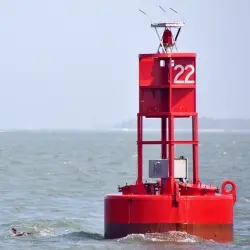
International Interlac 668
International Interlac 668 is a one pack, alkyd based, high visibility coating for application to marker buoys and as a safety marker on board ship. International Interlac 668 is for use at Newbuilding, Maintenance & Repair or On Board Maintenance.
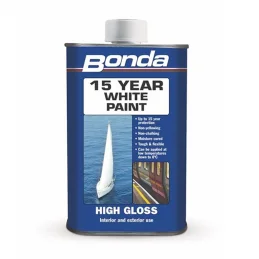
Bonda 15 Year Paint
Bonda 15 Year Paint is a one component, high gloss coating for metal, wood, aluminium and GRP. Formulated from premium moisture cured polyurethane with light fast pigments, 15 Year Paint has exceptional stability against U.V. light with outstanding non-yellowing and non-chalking qualities.Can be applied at a wide range of temperatures...
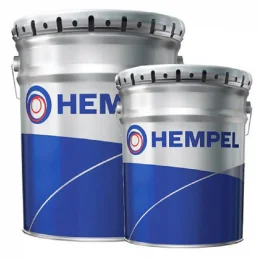
Hempel Hempadur Multi-Strength GF 35870
Amine adduct cured epoxy coating. Reinforced with glass flakes and cures to a hard, impact and abrasion resistant coating with good resistance to sea water and splashes from petrol and related products. Self-primed, high-build coating recommended for areas subject to abrasion and/or to a high corrosive environment e.g. splash zones, jetty...
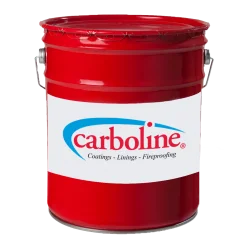
Carboline Carboguard 690 GF
Glass-flake filled, cold cure epoxy in semi-gloss white or yellow, with excellent film strength and resistance to water, salt water and wastewater exposures. Can be used on a variety of surfaces including structural steel, piping, pilings, ships, offshore structures, and other equipment exposed to industrial or marine environments. High...
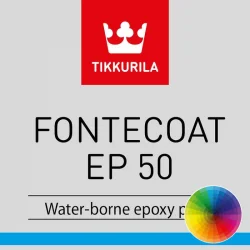
Tikkurila Fontecoat EP 50
Tikkurila Fontecoat EP 50, a two-component water-borne epoxy topcoat and a single-coat paint recommended for framework, service platforms, conveyors and other steelwork, machinery and equipment. The product has MED (Marine Equipment Directive) certificate no VTT-C-12360-15-18 and is thus accepted for painting surfaces inside ships.Huge...
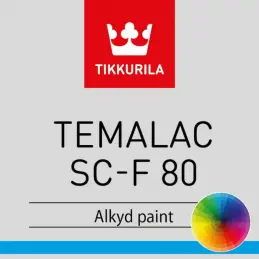
Tikkurila Temalac SC-F 80
4,000 gloss colours. High-solids single-coat alkyd paint containing anti-corrosive pigments, recommended as a single coat system for blast cleaned steel surfaces both indoors and outdoors. Good application properties. The product has MED (Marine Equipment Directive) certificate no VTT-C-11978-15-17 and is thus accepted for painting...
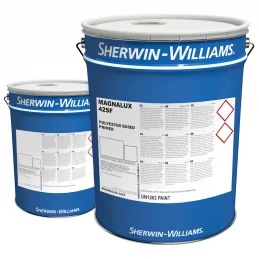
Sherwin-Williams Magnalux 42SF
Sherwin-Williams Magnalux 42SF is a 2-pack glass flake styrene free bisphenol polyester coating for steel surfaces prepared by abrasive blast cleaning in marine environments. It is recommended for applications where styrene is not desirable or prohibited. Part of the Magnalux rage of coatings.Approved to Norsok Rev 6 System 7A/7B Immersed...
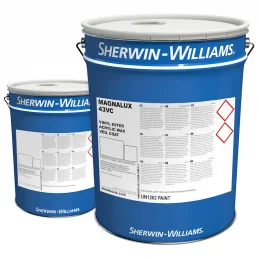
Sherwin-Williams Magnalux 43VC
Sherwin-Williams Magnalux 43VC is a two component resin-rich cold cured vinyl ester acrylic copolymer containing wax additives. Used as a protective coat over glass flake products in the Magnalux range of coatings.For use as a veil / topcoat in aggressive environments, which would attack the glass pigmentation in Magnalux Glass Flake...
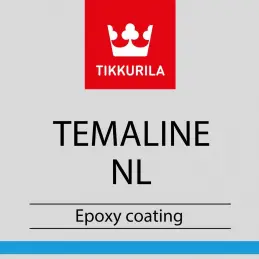
Tikkurila Temaline NL
2 component epoxy coating in black, grey or white. Low solvent content for navigation markers, sluices, interiors of coal, wood chip and peat containers, and other surfaces exposed to heavy mechanical abrasion. Excellent resistance to abrasion. Can be applied by standard airless spray equipment. Recommended for steel and concrete...
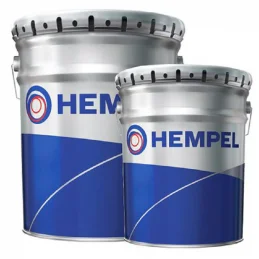
Hempel Hempadur Multi-Strength 35840
Solvent-free, two-component, high-build, polyamine adduct cured glass flake containing epoxy paint in 5 colours. Cures to a hard and tough coating with good resistance to abrasion, seawater and fresh water. Self-primed, high build coating for areas subject to a highly corrosive environment Can be used on pilings, offshore structures,...

Owatrol Owalak Premium Marine Enamel
Premium, high gloss marine enamel suitable for all substrates above the waterline. Excellent colour and gloss retention, ensuring a long-lasting, vibrant finish. Withstands extreme weather conditions with superior UV and anti-corrosive properties. Renews, protects, and decorates dull surfaces with good mechanical and chemical resistance....

Owatrol GLV Marine Aluminium Paint
Highly flexible, anti-corrosive coating with deep penetrating properties. Restores rusted and corroded surfaces to a gloss appearance for lasting protection. Excellent abrasion resistance and withstands chemical attacks. Ideal for aggressive climatic conditions, providing a high-resistant finish. Safe to use in confined areas, emitting...

Jotun MegaGloss AC
Two-component acrylic polyurethane topcoat with 2,400+ high gloss colours and excellent abrasion resistance. Suitable for application on prepared steel, aluminium, and composite surfaces in atmospheric environments. Certified for low flame spread in accordance with IMO FTP Code (light colours only). Designed for professional and...

Jotun EasyGloss
High-quality alkyd topcoat with a glossy finish, offering excellent colour retention. Excellent levelling properties. Fast-drying formula.

Jotun Racing
In 5 colours. Antifouling paint for protecting various underwater hulls. Provides a smooth, hard, and polishable surface. Protects for up to 12 months. No chalking effect over time.

Jotun Topgloss
Two-component acrylic polyurethane coating with excellent gloss retention. For yacht interiors, engine room machinery, and more. Resistant to temperatures up to 100 °C.
Need Help?
Need Help?
Marine and boat paint topcoats are indispensable in the world of maritime maintenance and construction. These specialised coatings are engineered to withstand the relentless assault of marine environments, which include prolonged exposure to saltwater, intense UV radiation, and the physical stresses associated with marine travel. The right topcoat paint not only forms a formidable barrier against these elements but also significantly extends the service life of the vessel or structure, reducing the frequency and cost of maintenance.
Understanding Marine Topcoats
Marine topcoat paints are formulated to provide the final layer of protection for various substrates, including fibreglass, steel, aluminium, and wood. The unique properties of these paints ensure they adhere effectively to these materials, creating a smooth and durable finish that is critical in preventing the onset of corrosion, a pervasive problem in marine environments. The topcoat serves as a shield that repels water and resists the penetration of salts and other corrosive agents, thereby preserving the integrity of the underlying material.
In addition to their anti-corrosive properties, marine topcoats are also highly resistant to UV radiation. Continuous exposure to sunlight can lead to the breakdown of inferior paints, causing them to chalk, fade, and ultimately lose their protective capabilities. Marine topcoat paints are specially designed to counteract these effects, maintaining their integrity and appearance over time, even under the most challenging conditions.
Key Features to Consider
Selecting the appropriate marine topcoat requires careful consideration of several key features that contribute to its overall effectiveness and suitability for specific applications:
- UV Resistance
UV resistance is a paramount feature for marine topcoats, as it prevents the degradation of the paint due to prolonged sunlight exposure. This feature ensures that the topcoat remains robust and protective, preserving both the structural integrity and visual appeal of the vessel over time.
- Chemical Resistance
Marine environments expose vessels to a variety of chemicals, including salt, fuel, oils, and industrial pollutants. A marine topcoat with strong chemical resistance is essential to protect the vessel from these corrosive substances, preventing damage to the substrate and maintaining the vessel’s operational integrity.
- Abrasion Resistance
The physical impacts and constant movement encountered in marine environments can lead to significant wear and tear on a vessel's surface. High-quality marine topcoats offer abrasion resistance, protecting the vessel from scratches, scuffs, and other surface damages that could compromise its protective barrier.
- Flexibility
Marine vessels and structures are subject to continuous movement and stress, making flexibility a critical attribute of marine topcoats. The paint must be able to flex and move with the substrate without cracking or peeling, especially in environments where temperature fluctuations are common. This flexibility is vital for maintaining the protective layer’s integrity under dynamic conditions.
- Colour Retention
A superior marine topcoat will retain its colour and gloss over time, even under the harsh conditions of a marine environment. This ensures that the vessel remains visually appealing and protected, reducing the need for frequent repaints or touch-ups.
- Ease of Application
Depending on whether the application is being carried out by professionals or DIY enthusiasts, the ease of application can be a crucial factor. Some topcoats are designed for spray application, offering a smoother finish, while others can be applied with brushes or rollers, providing versatility based on the user’s requirements.
- Compatibility with Primers and Undercoats
To achieve maximum adhesion and effectiveness, it is essential to choose a marine topcoat that is compatible with the primers and undercoats used on the vessel. This compatibility ensures that the entire protective system works harmoniously, providing comprehensive protection against the marine environment.
Common Applications of Marine Topcoat Paints
Marine topcoat paints are employed in a wide array of applications, each requiring specific considerations based on the operational environment and the nature of the vessel or structure:
1. Recreational Boats
Types of Recreational Boats: This category encompasses a wide range of vessels including yachts, speedboats, dinghies, sailboats, and personal watercraft like jet skis. Each type of boat presents unique challenges in terms of protection and aesthetics.
Key Considerations:
Aesthetics and Gloss Retention: Recreational boat owners often prioritize the appearance of their vessels. Marine topcoats used in these applications must offer excellent gloss retention and a wide variety of colour options. The ability to maintain a high-gloss, showroom-like finish over time, despite exposure to harsh marine conditions, is a significant selling point.
UV Protection: Recreational boats, especially those used in tropical and subtropical regions, are subjected to intense sunlight. UV protection is therefore critical to prevent chalking, fading, and the degradation of the topcoat, ensuring the vessel remains visually appealing.
Ease of Application and Repair: Many recreational boat owners may opt for DIY maintenance. As such, the ease of application (whether by brush, roller, or spray) and the ability to easily repair or touch up small areas of damage are important considerations. Products that cure quickly and allow for straightforward touch-ups are highly valued.
Example Applications:
Yachts and Luxury Boats
These vessels require topcoats that deliver not only durability but also a flawless finish that reflects their luxury status. Owners typically choose topcoats with superior colour depth and clarity, often in custom or metallic finishes.
Sailboats
For sailboats, the topcoat must withstand the dual challenges of saltwater exposure and the constant flexing of the hull under wind pressure. Flexibility and adhesion are therefore critical properties.
2. Commercial Vessels
Commercial vessels represent one of the most challenging categories for marine topcoat applications. These vessels, which include cargo ships, tankers, fishing boats, ferries, and more, operate under demanding conditions that require topcoats with exceptional durability, chemical resistance, and the ability to withstand significant wear and tear. Each type of commercial vessel has specific requirements based on its function and operational environment.
Cargo Ships
Role and Challenges: Cargo ships are the backbone of global trade, transporting vast amounts of goods across the world's oceans. These vessels are often exposed to harsh environmental conditions, including saltwater, UV radiation, and extreme weather. The constant loading and unloading of cargo, combined with the movement of the ship, subjects the surfaces to mechanical stress, which can lead to abrasions and impacts.
Key Topcoat Requirements:
Durability: The topcoat must offer exceptional durability to withstand the physical impacts associated with loading and unloading cargo, as well as the wear from constant movement at sea.
Chemical Resistance: Cargo ships often transport a wide variety of goods, including chemicals, oils, and other potentially corrosive materials. The topcoat needs to resist these substances to prevent degradation of the surface.
Low Maintenance: Given the scale of cargo ships, extensive maintenance is time-consuming and costly. Topcoats that require minimal maintenance and have long-lasting protective qualities are preferred to reduce downtime and operational costs.
Example Application:
Hull Coatings: The hull of a cargo ship is in constant contact with seawater, which accelerates corrosion. A topcoat with high anti-corrosive properties is essential to protect the hull and reduce drag, which in turn improves fuel efficiency.
Tankers
Role and Challenges: Tankers are specialized vessels designed to transport liquids, such as crude oil, refined petroleum products, chemicals, and liquefied natural gas (LNG). These vessels face unique challenges due to the nature of the cargo they carry. The potential for spills and the corrosive nature of many liquids necessitate a topcoat that offers both chemical resistance and durability.
Key Topcoat Requirements:
Chemical and Oil Resistance: The topcoat must resist the harsh effects of the chemicals and oils being transported. This resistance is crucial to prevent the cargo from damaging the vessel's structure and causing leaks or environmental contamination.
Heat Resistance: Some tankers transport liquids that require temperature control. The topcoat should be able to withstand temperature fluctuations without losing its protective properties.
Ease of Cleaning: After unloading, tankers often need to be cleaned thoroughly to avoid contamination when switching cargo types. A topcoat that is easy to clean and does not degrade with repeated washing is highly desirable.
Example Application:
Cargo Tank Linings: The interior surfaces of the cargo tanks in tankers are exposed to a variety of liquids that can be highly corrosive. A topcoat that provides a robust, chemical-resistant barrier is essential to prevent corrosion and ensure the integrity of the tanks.
Fishing Boats
Role and Challenges: Fishing boats, ranging from small trawlers to large factory ships, operate in some of the most challenging marine environments. These vessels are constantly exposed to saltwater, fish processing waste, and the physical demands of fishing operations. The surfaces must be protected against corrosion, mechanical damage, and biological growth.
Key Topcoat Requirements:
Saltwater Resistance: Given the nature of their operation, fishing boats are continuously exposed to saltwater, which is highly corrosive. The topcoat must offer superior resistance to saltwater to protect the vessel’s structure.
Abrasion Resistance: Fishing operations involve the use of heavy machinery and equipment that can cause significant wear and tear. The topcoat needs to be tough enough to withstand these mechanical impacts.
Hygiene and Cleanliness: Fishing vessels must comply with stringent hygiene standards to ensure that the catch remains safe for consumption. Topcoats that are easy to clean and do not harbour bacteria are essential.
Example Application:
Deck Coatings: The deck of a fishing boat is subjected to constant exposure to water, fish processing by-products, and mechanical impacts from equipment. A durable, slip-resistant topcoat that can withstand these conditions is crucial for maintaining safety and prolonging the deck’s lifespan.
Ferries and Passenger Ships
Role and Challenges: Ferries and passenger ships are designed to transport people rather than cargo. These vessels must combine safety with comfort, providing a pleasant environment for passengers while ensuring the vessel's structural integrity and longevity. Passenger ships often face high traffic, exposure to saltwater, and the need for regular cleaning and maintenance.
Key Topcoat Requirements:
Aesthetic Appeal: Passenger ships need to look good to attract and retain customers. The topcoat must offer excellent gloss retention and be available in a variety of colours to enhance the vessel's appearance.
Durability and Safety: The topcoat must withstand high foot traffic and exposure to environmental elements while maintaining a safe, non-slip surface for passengers.
Ease of Maintenance: Regular cleaning and maintenance are required to keep passenger ships in top condition. The topcoat should be easy to clean, resistant to staining, and capable of withstanding frequent washing.
Example Application:
Exterior Coatings: The exterior surfaces of ferries and passenger ships are constantly exposed to the elements, including saltwater and UV radiation. A high-gloss, UV-resistant topcoat that also offers anti-corrosive properties is ideal for maintaining the vessel’s appearance and structural integrity.
Tugboats and Workboats
Role and Challenges: Tugboats and workboats are small but powerful vessels designed for towing and assisting larger ships, as well as performing various tasks such as construction, dredging, and oil spill response. These vessels operate in close quarters with other ships and structures, leading to frequent impacts and abrasions.
Key Topcoat Requirements:
Impact and Abrasion Resistance: Tugboats often make contact with other vessels and structures, which can lead to abrasions and impacts. The topcoat must provide a tough, impact-resistant barrier that can withstand these forces.
Chemical Resistance: Workboats, particularly those involved in spill response or industrial tasks, may come into contact with chemicals, oils, and other potentially corrosive substances. The topcoat needs to resist these chemicals to protect the vessel.
Quick Recoatability: Tugboats and workboats often require rapid repairs and recoating to minimize downtime. Topcoats that allow for quick recoating and curing are beneficial in these operations.
Example Application:
Hull and Fender Coatings: The hull and fenders of tugboats are subjected to constant impacts and abrasion. A durable, impact-resistant topcoat is essential to protect these areas from damage and ensure the vessel's longevity.
Cargo Holds
Role and Challenges: Cargo holds are integral to the function of various commercial vessels, particularly bulk carriers, container ships, and tankers. These compartments are used to store and transport a wide range of materials, including grains, coal, chemicals, and other bulk goods. The conditions inside cargo holds can be harsh, with frequent exposure to moisture, salt, and abrasive materials, all of which can lead to rapid deterioration of unprotected surfaces.
Key Topcoat Requirements:
Corrosion Resistance: Cargo holds are often exposed to saltwater, either from the cargo itself (such as wet bulk goods) or through ingress during loading and unloading in port. The topcoat must provide excellent corrosion resistance to protect the structural integrity of the hold.
Chemical Resistance: In tankers and other vessels that transport chemicals, the cargo holds must be lined with topcoats that can resist corrosion from these substances. The topcoat should prevent the chemicals from degrading the metal surfaces, which could lead to contamination or leaks.
Abrasion Resistance: The loading and unloading of cargo, particularly abrasive materials like coal or ore, can cause significant wear on the surfaces of the cargo hold. The topcoat must be tough enough to withstand these abrasions, maintaining a protective barrier even after repeated impacts.
Ease of Cleaning: Cargo holds need to be cleaned regularly to prevent contamination when switching between different types of cargo. A topcoat that is resistant to staining and easy to clean helps ensure that the cargo hold remains in good condition and meets hygiene standards.
Example Application:
Interior Lining of Bulk Carriers: Bulk carriers transport materials such as coal, grain, and minerals that can be highly abrasive and corrosive. The interior lining of the cargo hold must be protected with a topcoat that resists both mechanical abrasion and chemical corrosion, ensuring the hold remains structurally sound and safe for cargo storage.
Commercial vessels, with their varied and demanding operational requirements, rely heavily on the performance of marine topcoat paints to ensure their longevity, safety, and efficiency. Whether it’s the interior of a cargo hold exposed to corrosive chemicals, the hull of a tanker braving the harshest seas, or the deck of a fishing boat subjected to constant abrasion and saltwater, the right topcoat can make a significant difference in the vessel's performance and maintenance needs. Understanding the specific challenges associated with each type of commercial vessel is crucial when selecting a topcoat, ensuring that the product chosen offers the necessary protection and durability for the application. For detailed product recommendations and expert advice on selecting the right topcoat for specific commercial vessels or cargo hold applications, contacting the technical support team at Rawlins Paints is highly recommended. Their expertise can help ensure that the chosen topcoat meets all operational requirements, extends the life of the vessel, and complies with relevant industry standards and regulations.
3. Naval and Military Ships
Types of Naval Vessels: This category includes a range of ships such as destroyers, frigates, aircraft carriers, submarines, and patrol boats. These vessels are often exposed to some of the most extreme and hostile environments on the planet.
Key Considerations:
Combat Durability: Naval ships must endure extreme conditions, including combat scenarios where the topcoat might be exposed to fire, impacts, and rapid changes in environmental conditions. The topcoat must be highly durable, fire-resistant, and able to maintain its protective qualities under these circumstances.
Low Infrared Reflectance: For military vessels, especially those that require stealth capabilities, topcoats may need to incorporate low infrared (IR) reflectance properties. This helps reduce the vessel's visibility to infrared detection systems.
Corrosion Resistance: Naval ships often operate in environments where the risk of corrosion is high, such as the Arctic or tropical waters. The topcoat must provide superior corrosion resistance to protect the vessel's critical infrastructure.
Operational Longevity: Military vessels are often deployed for extended periods without the opportunity for maintenance. The topcoat must be long-lasting and capable of providing continuous protection without requiring frequent touch-ups or reapplication.
Example Applications:
Aircraft Carriers and Submarines: The topcoats used on these vessels must protect against not only saltwater and UV radiation but also the harsh conditions of military operations, including exposure to aviation fuel, oils, and extreme temperatures.
Patrol Boats: These vessels require topcoats that can withstand high-speed impacts with water, debris, and potentially hostile environments, ensuring the safety and readiness of the craft at all times.
4. Offshore Structures
Offshore structures are engineered to operate in some of the most challenging environments on Earth, where they are subjected to relentless forces from both the sea and the atmosphere. These structures are often remotely located, making maintenance difficult and costly, and thus require topcoats that provide long-term durability and protection.
Types of Offshore Structures:
Oil and Gas Platforms: These include fixed platforms, floating production systems (FPS), tension leg platforms (TLP), and subsea systems.
Wind Farms: Offshore wind turbines, including monopile, jacket, and floating turbine structures.
Drilling Rigs: Both jack-up rigs and semi-submersible rigs used for offshore drilling activities.
Offshore Accommodation Modules: Temporary or permanent living quarters for offshore workers.
Subsea Equipment: Subsea manifolds, risers, and wellheads that form part of the subsea production systems.
Key Considerations:
Extreme Environmental Resistance: Offshore structures must endure severe weather conditions, including salt spray, high winds, and intense UV radiation. The topcoat must provide robust, long-lasting protection against these elements to prevent corrosion, which can compromise structural integrity.
Corrosion and Abrasion Resistance: These structures are constantly exposed to the erosive effects of saltwater, as well as physical impacts from waves, marine organisms, and operational equipment. The topcoat must resist corrosion while providing a tough, abrasion-resistant surface.
Extended Service Life: Maintenance of offshore structures is expensive and logistically challenging, often requiring specialised vessels and equipment. Therefore, the topcoat must be highly durable, extending the service life of the structure and minimising the frequency of maintenance operations.
Environmental Compliance: Offshore structures, particularly in the oil and gas sector, are subject to stringent environmental regulations. The topcoat must meet these regulations, ensuring low emissions and minimal impact on marine life.
Example Applications:
Oil and Gas Platforms:
Fixed Platforms: These platforms are anchored to the seabed and are constantly exposed to corrosive saltwater. The topcoat must protect both the submerged and topside sections, resisting corrosion and the physical impacts of waves and marine life.
Floating Production Systems (FPS): These systems operate in deep water and are exposed to both marine and atmospheric conditions. The topcoat must provide flexibility to accommodate the movement of the platform, as well as protection against the high levels of humidity and saltwater.
Subsea Systems: Equipment such as manifolds and wellheads are located on the seabed and require topcoats that can withstand high pressure, low temperatures, and biofouling. The topcoat must ensure the long-term functionality of these critical components.
Offshore Wind Farms:
Monopile Foundations: These are driven deep into the seabed and are constantly submerged, requiring topcoats with exceptional resistance to corrosion and biofouling. The topcoat must also be flexible to accommodate the structural stresses caused by the movement of the turbine.
Jacket Foundations: These multi-legged structures support wind turbines in deeper water. The topcoat must protect against corrosion at the joints and intersections, which are particularly vulnerable to stress and wear.
Floating Turbines: These turbines are moored to the seabed with tensioned cables and are subjected to dynamic forces from waves and wind. The topcoat must protect both the submerged and exposed sections of the turbine structure, ensuring long-term durability.
Drilling Rigs:
Jack-Up Rigs: These rigs are elevated above the water on extendable legs. The topcoat must protect the legs from corrosion during both the submerged and elevated phases, as well as provide resistance to the mechanical stress encountered during drilling operations.
Semi-Submersible Rigs: These rigs float on large pontoons and are anchored by mooring lines. The topcoat must be flexible enough to accommodate the movement of the rig, while also providing resistance to saltwater, UV radiation, and physical impacts from waves.
5. Marine Infrastructure
Marine infrastructure plays a crucial role in the operation of ports, harbours, and other coastal facilities. This infrastructure is subjected to constant exposure to marine conditions, requiring topcoats that offer superior protection against corrosion, wear, and environmental stress.
Types of Marine Infrastructure:
Docks and Piers: These include commercial shipping docks, recreational piers, and ferry terminals.
Bridges: Coastal and over-water bridges that connect landmasses, often in challenging marine environments.
Seawalls and Jetties: Structures designed to protect coastlines from erosion and provide safe harbours for boats.
Marine Terminals: Facilities for loading and unloading cargo, including container terminals and bulk material handling facilities.
Lighthouses and Navigational Aids: Structures that provide critical guidance to maritime vessels, often located in remote and exposed locations.
Key Considerations:
Heavy Traffic and Wear Resistance: Marine infrastructure is subjected to heavy mechanical loads from vehicles, equipment, and foot traffic. The topcoat must be durable and abrasion-resistant to withstand continuous wear and tear.
Corrosion Protection: Constant exposure to saltwater accelerates corrosion, which can weaken the structural components of marine infrastructure. The topcoat must provide a robust barrier to prevent rust and structural degradation.
Slip Resistance: Safety is a critical concern in areas with heavy traffic or exposure to water and oil. The topcoat may need to include slip-resistant properties to prevent accidents and ensure safe operation.
Chemical Resistance: Marine terminals and cargo handling facilities may expose infrastructure to a variety of chemicals, including fuels, oils, and industrial by-products. The topcoat must be resistant to these chemicals to protect the underlying structure.
Example Applications:
Docks and Piers:
Commercial Shipping Docks: These docks handle large vessels and heavy cargo, requiring topcoats that can withstand the physical impacts of docking ships, as well as the wear from heavy machinery and equipment. The topcoat must also resist corrosion from saltwater and chemicals used in cargo handling.
Recreational Piers: These structures are often used by smaller vessels and pedestrians. The topcoat must provide a durable, slip-resistant surface that is safe for public use, while also protecting against the corrosive effects of saltwater and UV exposure.
Bridges:
Coastal Bridges: Bridges that span coastal areas are subjected to harsh marine environments, including salt spray, high winds, and tidal action. The topcoat must protect the steel or concrete components from corrosion and provide long-term durability under continuous exposure.
Over-Water Bridges: These bridges, such as those connecting islands, are exposed to both saltwater and the physical stresses of vehicle traffic. The topcoat must provide a durable, corrosion-resistant surface that can withstand both environmental and mechanical wear.
Seawalls and Jetties:
Seawalls: Designed to protect coastlines from erosion, seawalls are continuously battered by waves and saltwater. The topcoat must provide exceptional resistance to corrosion and abrasion, ensuring the wall’s structural integrity over time.
Jetties: These structures guide and protect boats entering and leaving harbours. The topcoat must resist the erosive effects of waves and saltwater, while also providing a durable surface that can withstand physical impacts from boats and floating debris.
Marine Terminals:
Container Terminals: These facilities handle large volumes of cargo, requiring topcoats that can withstand the heavy wear from cranes, trucks, and containers. The topcoat must also resist corrosion from saltwater and chemicals used in cargo handling.
Bulk Material Handling Facilities: These terminals handle raw materials such as coal, ore, and grain. The topcoat must provide a durable surface that resists the abrasive action of these materials, as well as protection from saltwater and environmental exposure.
Lighthouses and Navigational Aids:
Lighthouses: Often located in remote and exposed locations, lighthouses are subjected to extreme marine conditions, including salt spray, high winds, and UV radiation. The topcoat must provide long-term protection against corrosion and weathering, ensuring the lighthouse remains functional and safe.
Buoys and Markers: Navigational aids such as buoys are continuously exposed to saltwater and physical impacts. The topcoat must provide a durable, corrosion-resistant surface that can withstand the harsh marine environment and ensure visibility and functionality.
6. Subsea and Immersed Structures
Types of Subsea Structures: This category includes submerged pipelines, underwater support structures for offshore platforms, jetties, and other permanently submerged installations.
Key Considerations:
Water and Pressure Resistance: Subsea structures are subjected to constant water pressure and immersion, which can accelerate the corrosion process. The topcoat must be highly resistant to water ingress and capable of withstanding the hydrostatic pressure at various depths.
Biofouling Resistance: Marine organisms, such as barnacles and algae, often attach themselves to submerged structures, leading to biofouling. The topcoat must include antifouling properties to prevent these organisms from compromising the structure.
Long-Term Durability: Due to the difficulty and expense of accessing subsea structures for maintenance, the topcoat must be exceptionally durable, providing long-term protection without the need for frequent reapplication.
Chemical Resistance: Subsea pipelines often carry oil, gas, or other chemicals, which can be corrosive. The topcoat must be able to resist these substances while preventing leaks and ensuring the integrity of the pipeline.
Example Applications:
Underwater Pipelines: These structures require topcoats that can withstand the constant pressure of water and prevent corrosion from both the external environment and the chemicals being transported. The topcoat must ensure the pipeline remains secure and leak-free.
Submerged Platforms and Jetties: The topcoat used on these structures must resist the buildup of marine organisms and prevent the corrosion that can compromise their stability and safety. The coating must remain effective even after years of submersion.
Marine Approvals and Certifications
Marine topcoat paints are often required to meet specific industry standards and certifications, which ensure their suitability for use in demanding marine environments. These approvals guarantee that the coatings have been tested and verified for performance, safety, and environmental impact, providing assurance to vessel owners, operators, and regulatory bodies:
NORSOK Standards
NORSOK standards are widely recognised within the oil and gas industry, particularly for offshore structures. These standards ensure that coatings provide adequate protection against corrosion, even in the harsh conditions typical of offshore environments. NORSOK certification indicates that the marine topcoat has passed rigorous testing for adhesion, flexibility, and resistance to chemicals and UV radiation. Using NORSOK-approved products ensures compliance with industry regulations and enhances the safety and longevity of marine assets, making them a preferred choice for offshore installations.
IMO (International Maritime Organization) Certification
The IMO sets global standards for the safety, security, and environmental performance of international shipping. Marine topcoats with IMO certification meet stringent requirements for fire resistance, toxicity, and environmental impact, ensuring they are safe for use on a wide range of vessels. IMO-certified topcoats are particularly important for commercial vessels and passenger ships, where compliance with international safety and environmental regulations is critical. This certification also ensures that the topcoats contribute to the overall safety and sustainability of maritime operations.
ISO (International Organization for Standardization) Standards
ISO standards for marine coatings cover various aspects, including quality management, environmental management, and specific performance characteristics. ISO-certified marine topcoats meet internationally recognised benchmarks for durability, corrosion resistance, and environmental safety. These certifications provide assurance that the topcoat will perform reliably in demanding marine conditions, making them suitable for both new constructions and maintenance projects. ISO certification also ensures that the products meet global standards for quality and environmental responsibility.
Lloyd’s Register Certification
Lloyd’s Register is a globally recognised classification society that certifies marine products for safety and performance. Marine topcoats with Lloyd’s Register approval have been tested and certified for use on ships and offshore structures, ensuring compliance with international standards. This certification is often required for vessels that must meet specific safety and operational criteria, particularly those operating in international waters. Lloyd’s Register certification provides confidence that the topcoats will deliver the necessary protection and durability in real-world marine conditions.
DNV GL (Det Norske Veritas and Germanischer Lloyd) Certification
DNV GL is another major classification society that provides certification for marine coatings. DNV GL-certified topcoats meet high standards for environmental protection, durability, and performance in marine environments. This certification is particularly relevant for vessels and structures operating in European waters, where compliance with DNV GL standards is often mandatory. DNV GL certification ensures that the topcoats are suitable for use in the most challenging marine environments, providing long-term protection and reducing the need for frequent maintenance.
BS EN ISO 12944 Certification
This certification pertains to the protection of steel structures from corrosion by protective paint systems. It is a comprehensive standard that specifies the types of coatings, their application methods, and the environmental conditions they are designed to withstand. Marine topcoats certified under BS EN ISO 12944 are guaranteed to provide effective corrosion protection for steel structures in marine environments, ensuring their long-term durability and safety.
MIL-SPEC (Military Specification) Compliance
For naval and military vessels, topcoats often need to comply with military specifications (MIL-SPEC) that dictate strict requirements for performance, durability, and safety. These specifications ensure that the topcoats can withstand the extreme conditions encountered in military operations, including exposure to chemicals, extreme temperatures, and physical impacts. MIL-SPEC-compliant topcoats are crucial for maintaining the operational readiness and safety of military vessels.
ABS (American Bureau of Shipping) Approval
ABS certification is another critical endorsement for marine topcoats, particularly for vessels and structures operating under American jurisdiction. ABS-approved topcoats are tested for their ability to protect against corrosion, UV damage, and mechanical wear in marine environments. This certification ensures that the topcoats meet the stringent safety and performance requirements set by the American Bureau of Shipping.
For detailed product recommendations and advice on the best combination of products for specific applications, it is advised to contact the technical support team at Rawlins Paints. They can provide expert guidance to ensure that the chosen products meet the specific needs of your vessel or marine structure, ensuring compliance with relevant standards and extending the life and performance of your marine assets.
